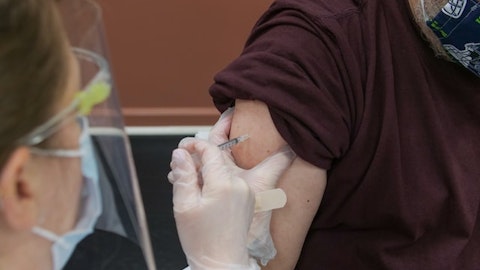I think this was already updated some weeks ago. That is reflecting the current speed of recruitment and our estimation. We always need to make and continuously explore how quick things are going forward, and therefore, we made an adaption to the timelines. But we are okay. We are on track on the current recruitment right now.
Caroline Pocher: Great. Thank you so much.
Daniel Vitt: Thank you, Caroline.
Jessica Breu: Thank you, Caroline. The next one I have in the queue here is Nat Charoensook from Leerink. Nat, please unmute yourself and go ahead. Nat, can you hear us?
Nat Charoensook: Hi. Can you hear me all right?
Jessica Breu: Yes. Hello. Good morning.
Nat Charoensook: Hi, there. This is Nat Charoensook on for Tom Smith. So congrats on all the progress, and we have couple of questions. So the first one like what are the biomarker results that we can expect from the interim analysis for the ESNURE study expected in late 2024, and what you need to see to continue the development of vidofludimus calcium in RMS.
Daniel Vitt: Yes. Thank you, Nat, for the question. And that’s good that you asked because I want to clarify that. This is, as we have written, this will be just a futility analysis. Since this is a Phase III study, we can’t read out biomarkers or other clinical data at this time point. So it will just be a futility analysis, and we would get feedback from the Data Safety Monitoring Board about progression of the study. It may allow us for sample size adjustment. So this is maybe the only outcome which could happen. Either continue as planned or sample size adjustment recommendations from the Data Safety Monitoring Board.
Nat Charoensook: Got it. That’s very helpful. So the next one is, so what are the gating factors to start a Phase II study in ongoing active celiac disease? And can you please go over a potential trial size for the Phase II study? I think you plan to look into like additional doses other than the 80 mg or 160 mg that you looked at in the Phase Ib study. And what are the potential endpoints as well as exploratory biomarkers you plan to include in the study?
Daniel Vitt: Yes, also a good question. As you know, we are heavily working and involved in a celiac disease committee in the space, given our wonderful readout from the proof-of-concept study last year, of course, that drove a lot of interest. And that is influencing our very active preparation time of a potential Phase II study in celiac disease. And also for potential other indications, as I said before. The more — the proof-of-concept we achieved in the Phase I is not only limited to celiac disease, because we have, for example, seen a very nice improvement of enterocyte function by increased uptake of nutrients like vitamin B12, for example. But also, this is also more or less proving that the drug may work in other situations where you want to increase the viability and the function of those cells.
With respect to Phase II, as we have said before, the Phase II study currently is not in our budget. So we are preparing a study. We have talks ongoing with potential partners and also looking for other ways to finance a full blown Phase II study. And we will keep the market informed as we progress on these discussions and the way forward. That may also mean that it’s not finally limited to celiac disease. Maybe one thing I need to clearly say here, it could really go beyond celiac disease as indication in that context.
Nat Charoensook: Got it. That’s very helpful. Thank you so much.
Jessica Breu: Thank you, Nat. We have a question that came in via the Q&A tool in writing, and it nicely fits to IMU-856, so I will read it. Can you provide any high level description of how potential partners view the drug and if completion of Phase II is prerequisite for them?
Daniel Vitt: As of my little bit subjective conclusion on perception of the drug is that people really think it’s cool stuff. It’s a new target. I think this has the potential really to address the GI disorders in a very different way. So lacking immunosuppressive effects is really a unique benefit we see here, and therefore, I think it is an attractive thing. On the other hand, typically, new targets need to demonstrate that they work. And to our favor, I think we have already achieved this clinical proof-of-concept in the celiac disease patients. So I think generally, the perception is very positive, and people are very excited about a completely new approach for those diseases.
Jessica Breu: Thank you, Daniel. The next one in the queue here is Matt Kaplan from Ladenburg. Matt, welcome. Please unmute yourself.
Matthew Kaplan: Hi. Good morning, guys. Can you hear me?
Jessica Breu: Good morning. Yes. Good morning.
Matthew Kaplan: Great. Well, congrats on the progress. I mean, I just wanted to kind of zero in on the data that you’ve gotten so far with vidofludimus in terms of the impact on NfL. I guess, what’s been the feedback so far you’ve received from the MS community KOLs with that observed pronounced reduction in the CALLIPER and EMPhASIS studies?
Daniel Vitt: Thank you. Good morning, Matt, and thank you for that question. I think this is unique and people see that. And given that recently, if you look on a couple of key publications in that space, there are very nice data showing that NfL is in progressive MS specifically, in an isolated way, if you really separate the activity of NfL from focal inflammation and relapses, on the one hand from the new regenerative contributions like you can do in progressive MS patients, there is clearly a nice predictive power of NfL for future disability outcome. And it was shown in a couple of recent papers. Specifically in the second half of last year, there were some papers really pointing to that. And that also drives excitement.



